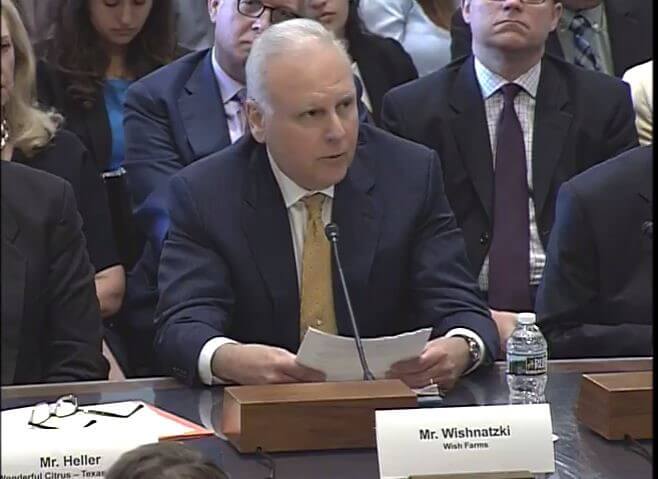Gary Wishnatzki, Wish Farms owner and head pixie, was one of five people asked to appear on Capitol Hill to represent the interests of hard-working specialty crop farmers. He wrote a guest column article exclusively for Southeast Produce Weekly, recapping his experience from that trip:
Most specialty crop growers agree that the availability of labor is the greatest challenge that the industry faces. The rising cost of labor is merely a secondary problem. In fact, all signs are pointing toward Mexico becoming a net importer of labor in the not too distant future.
You read that right. Mexico will not have enough labor to harvest the crops that are being grown in Mexico. What does that mean for American farms? It means that we will be in a full-blown crisis if we stick to the status-quo. All is not lost, yet. But, the industry needs to aggressively fund technology companies to find labor-replacement solutions to the many crops that we grow.
When I was called on by United Fresh Produce Association to testify before the House Committee on Agriculture last week, I gladly accepted the invitation. I was asked because of my experience as a co-founder of Harvest CROO Robotics and as owner of Wish Farms.
I arrived in Washington, D.C. a day early to get the lay of the land. Julie Manes, United’s Director of Government Relations, took me to several committee member’s offices to speak with staff and give them a preview of the issues.
“You can’t handle the truth.”
As we were touring the room where the testimony would take place, I had a chance encounter with House Agriculture Committee Chairman Mike Conaway of Texas. I shook his hand and he cordially greeted me. Jokingly, he looked at me and said, “We are going to get to the truth!” I instinctively shot back, “You can’t handle the truth!” We both had a laugh and went about our business. While the encounter was friendly and the exchange was purely tongue and cheek, I did have plans of telling it like it is. I wasn’t quite sure how that would be received.
The next morning, I felt prepared and comfortable, except for the fact that I was wearing a suit and tie in 95-degree weather. There were four other industry leaders appearing at the same hearing: Kevin Murphy, CEO of Driscoll’s, Paul Wenger, President of the California Farm Bureau Federation, Paul Heller, Vice President of Wonderful Citrus Texas, and Andrew LaVigne, President & CEO of American Seed Trade Association. We each had only 5 minutes to testify, followed by over 2 hours of questioning.
During the testimony, all of us drove home the serious issue of availability of labor and the current challenges of the H2A Guest Worker Program. The Ag Committee does not lead immigration issues, as that falls upon the Judiciary Committee. However, we urged members of the Ag Committee to be advocates for meaningful H2A reform.
My testimony focused on the fact that technology is the future, but made the point that we need help in the present. H2A is not a sustainable solution, but it is a short-term way to bridge the gap until robotics in agriculture become ubiquitous.
“There is an easy way to fix it.”
In my written testimony, I presented an idea on how a guest worker program should be designed. Now, I did not have time to go through the details in my 5 minutes, so I strategically stated that there is an “easy way to fix it”. It worked, because my seemingly cavalier statement invited a follow-up question from one of the Congressmen. After a momentary chortle, I went on to explain my idea, which centers around the final bullet point.
• USDA establishes quotas for the total number of workers needed monthly for all crops in the U.S.
• Agricultural work visas are issued to workers with agricultural work experience.
• The visas stipulate agriculture as the industry that they are allowed to work in and it stipulates the time they are allowed to stay.
• Workers are not tied to a specific employer and can freely move from farm to farm. This helps ensure fair treatment of workers, because they are not tied to one grower.
• E-verify is implemented.
• USDA establishes a clearinghouse to point workers to areas and farms where they are needed.
• H2A workers are responsible for their own housing, just as domestic workers are.
• Guest workers are paid the same wages as domestic workers, with one important catch: Withhold a heavy amount of their wages until they return to their home country. While in the U.S., they would receive a stipend for necessities. This should ensure that workers do not overstay their visas.
Currently, our industry has no other option but to rely on foreign-born labor to do the essential jobs needed to get our crops harvested. It’s important to understand that the primary reason for the shrinking farm labor supply is simple demographics. The majority of farmworkers come from other countries, particularly Mexico.

Throughout the history of our country, newly arrived immigrants have done the jobs that Americans do not want to do. Newcomers are more willing to do hard jobs.
Understandably, most workers eventually move into other occupations that are not as tedious or that have more opportunity for advancement. Furthermore, most harvesting jobs are not conducive to older people. Workers are looking for a better life for their children, so it’s rare that the second generation becomes farm laborers.
For years, American farms have depended on the newly arrived immigrants. Today growers are turning to H2A because people are no longer coming in the numbers that they once did. Here is why: in the 1960’s the fertility rate in Mexico was 6.7. People were coming here because there were no opportunities at home. Twenty years ago, it had dropped to 2.9. That shrinking birthrate mirrors the declining farm labor force we have seen over the last 10 years. Today, our 20-year-old workers are represented by the 2.9% fertility rate of 1997. What should really cause growers concern, is that the current fertility rate in Mexico is estimated to be at 2.1.
“Easy to see which way labor trends are heading.”
If that is any preview of what the next 20 years looks like, it is easy to extrapolate that the trend of a shrinking and aging labor force is going to continue. There are many more opportunities for work in Mexico nowadays, so they are not coming anymore. Pew Research Center published a paper in 2015 that concluded there are more people going back to Mexico than are coming to the U.S. The group of workers that we have in the U.S. is shrinking, aging, and becoming less productive.
Another point to glean from the demographics is that Mexico will also soon be short on agricultural labor. With their specialty crop industry expanding at a rapid pace, before long, Mexico will be one of the countries importing labor. When I first founded Harvest CROO Robotics, I did not believe that there was a need to prosecute patents in Mexico because their labor costs were so low. Based on current trends, I now believe that will change within the next 10 years. All of our patents have now been filed in Mexico.
Innovation will be the key to maintaining our nation’s ability to feed itself. Our representatives should fight for investments in technology and research in the specialty crop sector, while also providing a better way to access labor in the short-term. The Committee listened to the truthful facts presented, so the question is: can they handle the truth?
To view the original published article – please click here.
To learn more about Harvest CROO and the future of agriculture, you can read all about the latest updates in this Gary’s Corner article.















